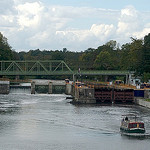
Historian Warren Roberts begins the chapter on “Albany and the Erie Canal” in his book “A Place in History: Albany in the Age of Revolution, 1775-1825” by declaring, “The Erie Canal is one of the most important transportation projects in all of American history.” The Erie Canal is approaching its bicentennial in 2025. It is hard to underestimate how transformational its creation was to the nation. Yet, why can’t we realize its potential as what former Gov. George Pataki called one of New York’s most valuable resources?
Visions for a new chapter for the Erie Canal came from Pataki when he was governor, Andrew Cuomo when he was the U.S. housing secretary, members of Congress when the Erie Canalway National Heritage Corridor was established and Peter Tufo, chairman and CEO of the Thruway Authority when Mario Cuomo was governor.
Little of that potential has been realized. The Erie Canal is threatened every time a Thruway toll increase is proposed. Tufo led the preparation of the Canal Recreationway Plan and called the scenic vistas that appear when a canal lock lifts travelers to new water levels as being “like a Verdi opera.”
Tufo envisioned the Canal Authority doing for upstate what the Port Authority of New York and New Jersey does for economic development downstate. He proposed goals to Pataki including “piers, restaurants, retail shops, information kiosks, picnic tables and trail amenities” along an end-to-end trail from Buffalo to Albany as well “tourist clusters” at Tonawanda, Rochester, Oswego, Seneca Falls, Little Falls and Whitehall. Planners believed the increase in tourism would create 2,700 jobs and pump $230 million into the state’s economy by attracting 1.3 million visitors.
I thought Pataki would jump at a project that would benefit traditionally Republican upstate New York, but Thruway interests killed it. The best Pataki did for the canal was the not-so-bold “bold new vision to create an ‘Erie Canal Greenway.'” It was a news release solution.
As Pataki dropped the ball, Cuomo announced a Canal Corridor Initiative for the Department of Housing and Urban Development to provide $74.2 million in low-interest loan guarantees and $56.8 million in grants along the entire Erie Canal Corridor and connecting waterways. Members of the New York congressional delegation announced legislation to designate the Erie Canal to be a National Heritage Corridor. The results were small steps forward for some Canal communities.
Cuomo recently announced an upgrade to the state’s tourism program to attract more visitors to economically struggling upstate. The report in the New York Daily News on this tourism revival didn’t mention the Erie Canal that Tufo believed could be an international attraction. It also didn’t mention the marketing power that could come from a bicentennial celebration for the Erie Canal looking forward to the emerging technologies across the state.
To be serious about upgrading upstate tourism, it is time to go back to Tufo’s vision from the Mario Cuomo era and hitch it to the Erie Canal bicentennial as a means to capture the attention of the whole state, the nation and the world.
The Erie Canal is not only a recreational asset; it symbolizes a dynamic state that opened commerce to the Great Lakes. It sparked the development of upstate cities and allowed New York City to become a world-class city.
In addition, builders of the Erie Canal moved on after its completion to build the Ohio & Erie Canal. Roberts wrote, “the success of the Erie Canal was so great that it ignited a ‘canal fever’ that swept across America.” According to Roberts, “it contributed to a shift in the geographical center of economic activity, giving America a new place in the world community of nations.”
The Erie Canal bicentennial should have a national series of events. One of many benefits for us, for example, could be learning how the Ohio & Erie Canal counties like Tuscarawas County were inspired by their canal to create a countywide trail and green space system.
Some of the historic steps that led to the building of the Erie Canal have already had their 200th anniversary. Time is running out to launch the commemoration of the canal we deserve.
This article originally appeared in the Albany Times Union on November 8, 2012.


